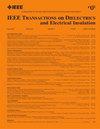The Electrical Conductivity Characteristics of Polyimide During the Thermal Cycle
IF 2.9
3区 工程技术
Q2 ENGINEERING, ELECTRICAL & ELECTRONIC
IEEE Transactions on Dielectrics and Electrical Insulation
Pub Date : 2024-09-23
DOI:10.1109/TDEI.2024.3465468
引用次数: 0
Abstract
2 K/min and even faster rates of thermal cycle environments in low earth orbit alter the electrical conductivity characteristics of polyimide, which may exacerbate charge accumulation and electrostatic discharge (ESD) and seriously threaten the safety of spacecraft. This work focuses on the conductivity characteristics during the thermal cycle by leakage current measurement and demonstrates that the multiple energy levels traps play an important role in conductivity by the thermally stimulated depolarization current (TSDC) measurements. The results show that the current has a nonmonotonic temperature dependence with polar peaks and decreases periodically during the 5 K/min thermal cycle. After 24 thermal cycles, there is a 77.3% reduction in conductivity at 343 K and a 54.0% reduction compared with the 343 K steady-state temperature. The conductivity increases when the thermal cycle rate increases to 10 K/min. The results attribute to the combined effect of nonunidirectional dipole steering, thermally stimulated detrapping effects dominated by the shallower energy levels热循环过程中聚酰亚胺的电导率特性
2 K/min甚至更快的近地轨道热循环环境改变了聚酰亚胺的导电特性,可能加剧电荷积累和静电放电(ESD),严重威胁航天器安全。本文主要通过泄漏电流测量热循环过程中的电导率特性,并通过热刺激去极化电流(TSDC)测量证明了多能级阱在电导率中起重要作用。结果表明,在5 K/min的热循环周期内,电流与极峰具有非单调的温度依赖性,并周期性地减小。经过24个热循环,温度为77.3% reduction in conductivity at 343 K and a 54.0% reduction compared with the 343 K steady-state temperature. The conductivity increases when the thermal cycle rate increases to 10 K/min. The results attribute to the combined effect of nonunidirectional dipole steering, thermally stimulated detrapping effects dominated by the shallower energy levels $\beta _{{1}}$ and $\beta _{{2}}$ traps, and trap-filling effects dominated by the deeper energy levels $\beta _{{3}}$ and $\alpha $ traps. The findings in this study can provide experimental support to reveal the conductivity variation mechanisms in time-varying temperatures.
本文章由计算机程序翻译,如有差异,请以英文原文为准。
求助全文
约1分钟内获得全文
求助全文
来源期刊
CiteScore
6.00
自引率
22.60%
发文量
309
审稿时长
5.2 months
期刊介绍:
Topics that are concerned with dielectric phenomena and measurements, with development and characterization of gaseous, vacuum, liquid and solid electrical insulating materials and systems; and with utilization of these materials in circuits and systems under condition of use.

 求助内容:
求助内容: 应助结果提醒方式:
应助结果提醒方式:


